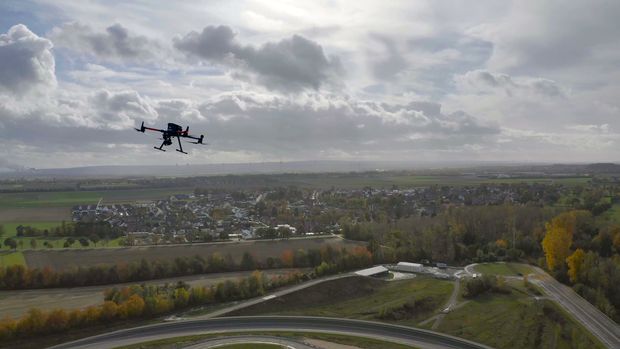
The technology allows drone operators to deliver supplies quickly, while maintaining their connection to the mobile network.
Photo courtesy of Vodafone and Ericsson
Ericsson ERIC, +0.64% and Vodafone VOD, +2.23% said that they have successfully tested technology that uses mobile network data to facilitate flight corridors for drones, opening the door to safer and more accurate flights for commercial and emergency purposes.
In a trial this month in Germany, the two European telecom giants used data from mobile networks to produce coverage maps to allow a drone to stay in areas with good signal up in the air.
The technology allows drone operators, including emergency services, to deliver supplies quickly, while maintaining and optimizing the connection to the mobile network, which is crucial for flight.
The trial also used another technology from Vodafone to collate anonymized and secured mobile user data on the ground, which allowed the drone to avoid heavily crowded areas.
“The mobile network is a data-rich asset that can be responsibly and securely used to aid society,” said Vodafone’s chief technology officer, Johan Wibergh.
Vodafone is able to provide both the coverage map data and collated user data to trusted third parties through an Application Programming Interface, which is a critical intermediary between applications that allows softwares to “talk” to each other.
The companies said that using APIs to funnel data to drone operators would allow pilots to quickly and easily plot a predetermined path for the drone while maintaining contact with the control center, even when out of sight.
“APIs will speed up the adoption of drones for commercial and public sector use,” Wibergh said, “bringing many benefits such as being able to assess fires, deliver medical supplies, and help businesses survey hazardous conditions like construction sites, power lines and our own mobile masts, quicker and more safely.”
In a separate test simulation, in Spain, Vodafone used a 5G-enabled drone to fly a lightweight defibrillator to the scene of a patient experiencing cardiac arrest.
The use of flying drones is viewed by many companies as the next frontier in last-mile distribution and immediate delivery.
In August, the Federal Aviation Administration granted approval for e-commerce giant Amazon AMZN, -0.63% to deliver packages by drone, which the company has been testing.
However, there are still many barriers to the widespread deployment of drones, including performance in adverse weather, battery range, and common obstacles such as power lines and trees — which Ericsson and Vodafone’s technology may be able to address.
Public opinion is another hurdle to clear. In a population survey conducted earlier this year by the Berlin Institute of Technology and nonprofit Wissenschaft im Dialog (Science in Dialog), 41% of respondents said that drones should only be used for emergencies, such as the rapid delivery of medicine. Most respondents were opposed to the use of delivery drones.










Add Comment